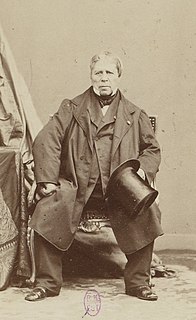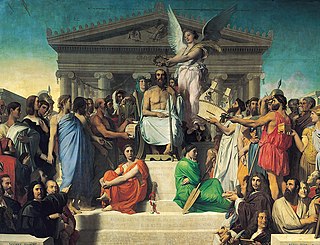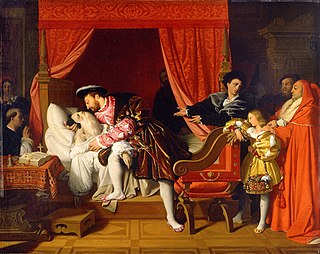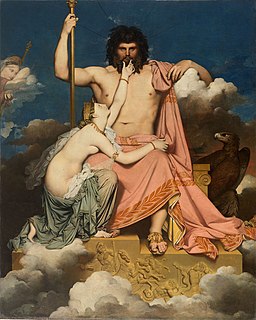 W
WJean-Auguste-Dominique Ingres was a French Neoclassical painter. Ingres was profoundly influenced by past artistic traditions and aspired to become the guardian of academic orthodoxy against the ascendant Romantic style. Although he considered himself a painter of history in the tradition of Nicolas Poussin and Jacques-Louis David, it is his portraits, both painted and drawn, that are recognized as his greatest legacy. His expressive distortions of form and space made him an important precursor of modern art, influencing Picasso, Matisse and other modernists.
 W
WThe Ambassadors of Agamemnon in the tent of Achilles is an 1801 painting by Jean-Auguste-Dominique Ingres, produced for the Prix de Rome competition. It is now in the École nationale supérieure des beaux-arts in Paris.
 W
WThe Apotheosis of Homer is a grand 1827 painting by Jean-Auguste-Dominique Ingres, now exhibited at the Louvre as INV 5417. The symmetrical composition depicts Homer being crowned by a winged figure personifying Victory or the Universe. Forty-four additional figures pay homage to the poet in a kind of classical confession of faith.
 W
WAretino and Charles V's Ambassador is a painting by the French artist Jean-Auguste-Dominique Ingres, produced in an 1815 and an 1848 version. It is in the troubador style and shows Pietro Aretino facing Charles V's ambassador, who is trying to bribe him.
 W
WThe Dauphin's Entry Into Paris is an 1821 painting by Jean-Auguste-Dominique Ingres. It is now in the Wadsworth Atheneum collection.
 W
WThe Death of Leonardo da Vinci is an 1818 painting by the French artist Jean Auguste Dominique Ingres, showing the painter Leonardo da Vinci dying, with Francis I of France holding his head. It was commissioned by the Pierre Louis Jean Casimir de Blacas, the French ambassador in Rome, and now hangs in the Petit Palais in Paris.
 W
WDon Pedro of Toledo Kissing Henry IV's Sword is an 1814 painting in the Troubador style by the French artist Jean-Auguste-Dominique Ingres, showing the Spanish ambassador Pedro Álvarez de Toledo, 5th Marquis of Villafranca kissing the sword of Henry IV of France in the salle des Caryatides of the Louvre palace. The painting is now lost. Between 1819 and 1832, Ingres painted three additional paintings of the subject.
 W
WLa Dormeuse de Naples was an 1809 painting by the French artist Jean-Auguste-Dominique Ingres, now lost. He reused the pose in two later works, Odalisque with Slave (1839) and Jupiter and Antiope (1851).
 W
WGrande Odalisque, also known as Une Odalisque or La Grande Odalisque, is an oil painting of 1814 by Jean Auguste Dominique Ingres depicting an odalisque, or concubine. Ingres' contemporaries considered the work to signify Ingres' break from Neoclassicism, indicating a shift toward exotic Romanticism.
 W
WThe Half-Length Bather is an 1807 painting by the French artist Jean-Auguste-Dominique Ingres. It is now in the Musée Bonnat in Bayonne.
 W
WHenry IV Receiving the Spanish Ambassador is an 1817 painting in the Troubador style by the French painter Jean Auguste Dominique Ingres. It shows Henry IV of France playing with his children whilst receiving the Spanish ambassador, with Marie de Medici seated at the centre.
 W
WThe Sickness of Antiochus or Stratonice and Antiochus is an 1840 painting by the French artist Jean Auguste Dominique Ingres. It is now in the Musée Condé in Chantilly.
 W
WJoan of Arc at the Coronation of Charles VII is an 1854 painting by Jean Auguste Dominique Ingres. It is now in the Louvre Museum in Paris.
 W
WJupiter and Thetis is an 1811 painting by the French neoclassical painter Jean Auguste Dominique Ingres, in the Musée Granet, Aix-en-Provence, France. Painted when the artist was yet 31, the work severely and pointedly contrasts the grandeur and might of a cloud-born Olympian male deity against that of a diminutive and half nude nymph. Ingres' subject matter is borrowed from an episode in Homer's Iliad when the sea nymph Thetis begs Jupiter to intervene and guide the fate of her son Achilles; who was at the time embroiled in the Trojan War.
 W
WThe Martyrdom of Saint Symphorian is an 1834 painting by Jean-Auguste-Dominique Ingres. It shows the death of Saint Symphorian, the first Christian martyr in Gaul. Painted in oil on canvas and measuring 407 x 339 cm, it is now in Autun Cathedral. Although Ingres considered the painting—completed only after ten years of diligent work—one of his crowning achievements, it was criticized harshly when he exhibited it in the Paris Salon of 1834. It subsequently has been considered emblematic of Ingres' misguided ambition to excel as a history painter.
 W
WOdalisque with Slave is an 1839 painting by Jean-Auguste-Dominique Ingres commissioned by Charles Marcotte. Executed in oil on canvas, it depicts a nude odalisque, a musician, and a eunuch in a harem interior. The painting is in the Fogg Art Museum in Cambridge, Massachusetts. It is a classic piece of Orientalism in French painting.
 W
WThe Odyssey is an 1850 painting by Jean Auguste Dominique Ingres, showing a female personification of the eponymous poem by Homer. It is now in the Museum of Fine Arts of Lyon.
 W
WOedipus and the Sphinx is a painting by the French Neoclassical artist Jean Auguste Dominique Ingres. Originally a student work painted in 1808, it was enlarged and completed in 1827. The painting depicts Oedipus explaining the riddle of the Sphinx. An oil painting on canvas, it measures 189 x 144 cm, and is in the Louvre, which acquired it in 1878.
 W
WPaolo and Francesca is a painting by the French artist Jean-Auguste-Dominique Ingres, produced in seven known versions between 1814 and 1819. It derives from the story of Paolo and Francesca in Dante's Inferno. With Ingres' The Engagement of Raphael, these works represent early examples of the troubador style.
 W
WRaphael and La Fornarina was painted in 1813, in Italy, by Jean-Auguste-Dominique Ingres. It is the first of five versions of the painting, which he completed between 1813 and his death in 1867. In 1814 his first version was exhibited at the Salon. The work shows the renowned painter, Raphael, sitting in his studio with his mistress, La Fornarina, on his knee. His embrace reflects his affection and desire for her, while his gaze towards his own artwork, his portrait of his mistress, indicates his love for art. This contrast represents the painter's major conflict between who he loves and what he loves. The mistress makes eye contact with the viewer and her posture, specifically her arms resting on his shoulders, shows how proud and satisfied she is with being his mistress and inspiration. The Fornarina's sensual gaze at the viewer claims her importance and place both within the artist's studio and profession. Although Ingres thoroughly researched the Renaissance artist's life through biographies by Giorgio Vasari and Angelo Comolli, and planned to create a series of paintings based on his life, in the end he only produced two scenes: Raphael and La Fornarina, and its succeeding versions, and the Betrothal of Raphael. The depiction of the Fornarina resembles not only the Virgin Mary, in the painting in the background of the Madonna della seggiola, but also Ingres' depiction of the promiscuous Grande Odalisque. The illustration highlights an interconnection between Raphael and Ingres as they both paint what they desire.
 W
WRoger Freeing Angelica or Ruggiero Freeing Angelica is an 1819 painting by Jean-Auguste-Dominique Ingres, inspired by Orlando Furioso by Ariosto. An oil painting on canvas measuring 147 x 199 cm, it is owned by the Louvre. Ingres subsequently painted several variants of the composition.
 W
WRomulus' Victory Over Acron is a painting completed in 1812 by the French Neoclassical artist Jean-Auguste-Dominique Ingres. Ingres' source for this subject comes from Plutarch's Life of Romulus. The painting depicts the war that resulted from the Roman abduction of the young Sabine women in an effort to remedy the shortage of women in the newly founded city of Rome. In retaliation Acron, the king of the neighbouring tribe, the Caeninenses, declared war upon the Romans. He and his tribesmen were mercilessly defeated and their city sacked by the Romans.
 W
WThe Source is an oil painting on canvas by French neoclassical painter Jean Auguste Dominique Ingres. The work was begun in Florence around 1820 and not completed until 1856, in Paris. When Ingres completed The Source, he was seventy-six years old, already famous, and president of the École des Beaux-Arts. The pose of the nude may be compared with that of another by Ingres, the Venus Anadyomene (1848), and is a reimagination of the Aphrodite of Cnidus or Venus Pudica. Two of Ingres' students, painters Paul Balze and Alexandre Desgoffe, helped to create the background and water jar.
 W
WThe Turkish Bath is an oil painting by Jean-Auguste-Dominique Ingres, initially completed between 1852 and 1859, but modified in 1862. The painting depicts a group of nude women at a pool in a harem. It has an erotic style that evokes both the Near East and earlier western styles associated with mythological subject matter. The painting expands on a number of motifs that Ingres had explored in earlier paintings, in particular The Valpinçon Bather (1808) and La Grande odalisque (1814).
 W
WThe Valpinçon Bather is an 1808 painting by the French Neoclassical artist Jean Auguste Dominique Ingres (1780–1867), held in the Louvre since 1879. Painted while the artist was studying at the French Academy in Rome, it was originally titled Seated Woman but later became known after one of its nineteenth-century owners.
 W
WVenus Anadyomene is a painting by the French painter Jean-Auguste-Dominique Ingres. It is now held at the Musée Condé, Chantilly, France. It is a female nude of the Venus Anadyomene type, showing the goddess Venus rising from the sea.
 W
WThe Vow of Louis XIII is an 1824 painting by Jean-Auguste-Dominique Ingres, now in Montauban Cathedral. It shows a vow to the Virgin Mary by Louis XIII of France. It is an oil painting on canvas measuring 421 x 262 cm.